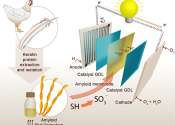Inspired by the human ear, a new acoustic fabric converts audible sounds into electrical signals
Having trouble hearing? Just turn up your shirt. That's the idea behind a new "acoustic fabric" developed by engineers at MIT and collaborators at Rhode Island School of Design.
Mar 16, 2022
2
147









